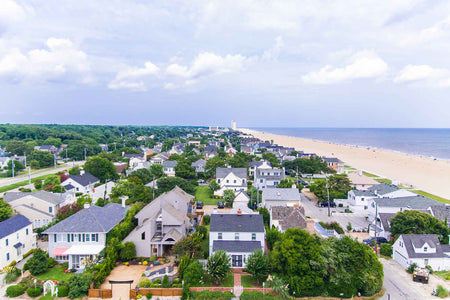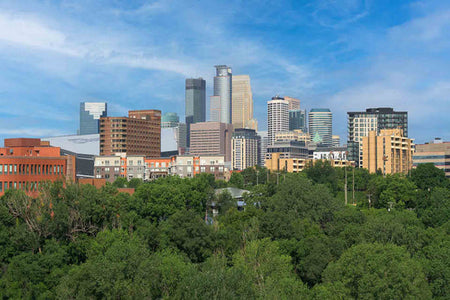- In Ohio, tee pollen peaks in spring (February–May), grass pollen in summer (May–June), and weed pollen in fall (August–November).
- Major allergens include oak, birch, ryegrass, and ragweed.
- Allergy prevention and management tips include monitoring pollen counts, staying indoors on high pollen days, and using treatments like nasal sprays.
If you’ve ever felt your nose run or your eyes itch while spending time outside, you might be experiencing allergies caused by pollen. In Ohio, pollen is a common outdoor allergen that can make spring, summer, and fall a challenging time for those who are sensitive to it. Tree, grass, and weed pollen fill the air during these seasons.
But outdoor allergens aren’t the only problem. Pollen can easily travel indoors and stick to clothes, pets, and furniture. This makes allergy symptoms even harder to avoid.
In this article, we’ll explore when pollen season starts and ends in Ohio and what types of pollen are most common. More importantly, we'll share the best tips to prepare for seasonal allergies.
When is the Pollen Season in Ohio?
Pollen season in Ohio typically starts in February and ends in November. This aligns with the seasonal patterns of pollen release from trees, grasses, and weeds.
In the spring, from February to May, tree pollen is the main cause of allergies. Most trees release their pollen from March to May, but the season can begin as early as February.
During the summer, from May to June, grass pollen takes over. Grass pollen levels typically decrease by July due to hotter weather. In the fall, from August to November, weed pollen becomes the biggest trigger. Ragweed is one of the most common causes of fall allergies across the Midwest [*].
While this is the general pattern, the exact timing and intensity of these seasons can vary each year. Weather conditions like temperature and rainfall can influence plant growth and pollen release.
What are the Worst Months for Allergies in Ohio?
The worst months for allergies in Ohio are April, June, and September because pollen levels are the highest. Here’s a detailed breakdown of allergy peaks:
- April: This month is characterized by a peak in tree pollen from species such as oak, birch, and maple.
- June: During June, grass pollen becomes the dominant allergen. Grasses like ryegrass and bluegrass are significant contributors to allergy flare-ups.
- September: Ragweed can produce pollen until November. However, its levels are particularly high in September.
When Does Pollen Season End in Ohio?
Pollen season in Ohio typically ends in November, although it can sometimes last until the first frost. The arrival of the first frost is a natural end to pollen season, as it kills off many of the plants that produce allergens [*]. However, the exact timing can vary each year depending on the weather and when the first frost occurs.
Common Pollens in Ohio
In Ohio, the most common types of pollen are from trees, grasses, and weeds.
Common trees in Ohio that produce pollen in the spring include:
- Oak
- Maple
- Pine
- Birch
- Cedar
- Hickory
- Juniper
- Cottonwood
- Ash
- Elm
- Mulberry
Common grass in Ohio that produces pollen during late spring and early summer include:
- Timothy
- Kentucky (common in lawns and parks)
- Ryegrass
- Orchard
- Bermuda
Common weed in Ohio that produces pollen during the fall include:
- Ragweed (the most allergenic weed)
- Pigweed
- Lamb’s quarter
- Plantain
- Sagebrush
How to Prepare for Seasonal Allergies in Ohio
Dealing with seasonal allergies can feel overwhelming, but taking action can make a big difference. It’s not just about knowing what to do — it’s about staying consistent with these steps to reduce your exposure to allergens:
- Check local pollen counts: Look up Ohio’s daily pollen counts online or through a weather app. This will help you decide if it’s a good day to spend time outside or if you should stay indoors to avoid too much pollen.
- Stay indoors when pollen is high: When pollen levels are high, try to stay indoors as much as you can. This will lower your chances of breathing in pollen and triggering allergy symptoms like sneezing or itchy eyes.
- Keep windows closed: Keep the windows in your house and car shut during allergy season. This keeps pollen from coming inside and helps make the air indoors cleaner.
- Install HEPA filters: HEPA filters can trap tiny pollen particles. Add these to your home’s air system or get a portable air purifier to improve the air quality inside.
- Clean regularly: Dust and vacuum regularly to get rid of pollen that might have settled on floors and surfaces. Use a vacuum cleaner with a HEPA filter to make sure you’re removing as many allergens as possible.
- Take your allergy medications: One option to try is Allermi Nasal Spray, a personalized combination nasal spray. Unlike other sprays, it combies up to 3 to 4 active ingredients to match your unique symptoms for optimal relief. It works fast and gives long-lasting relief from allergies.
- Wear a pollen mask: If you must go outdoors on high pollen days, wear a pollen mask to reduce the amount of pollen you breathe in. This can be especially helpful during yard work or outdoor exercise.
- Shower and change clothes: After spending time outside, shower and change clothes, especially before sitting on furniture or getting into bed. This helps keep pollen from spreading inside your home and causing allergy symptoms.
The Bottom Line
Seasonal allergies in Ohio are triggered by tree pollen in spring, grass pollen in summer, and weed pollen in fall, with the worst months being April, June, and September.
As long as you know when pollen season starts, what types of pollen are most common, and how to reduce your exposure, you can take charge of your allergies.
Remember to follow the simple steps we discussed, and use effective treatments like the Allermi Nasal Spray. If your symptoms persist or you need personalized advice on medication, don’t hesitate to consult an allergist.
References:
- Seasonal Allergies | Causes, symptoms & treatment | ACAAI Public website. (2022, November 7). ACAAI Patient. https://acaai.org/allergies/allergic-conditions/seasonal-allergies/
- Climate change indicators: Ragweed pollen season | US EPA. (2025, January 15). US EPA. https://www.epa.gov/climate-indicators/climate-change-indicators-ragweed-pollen-season









